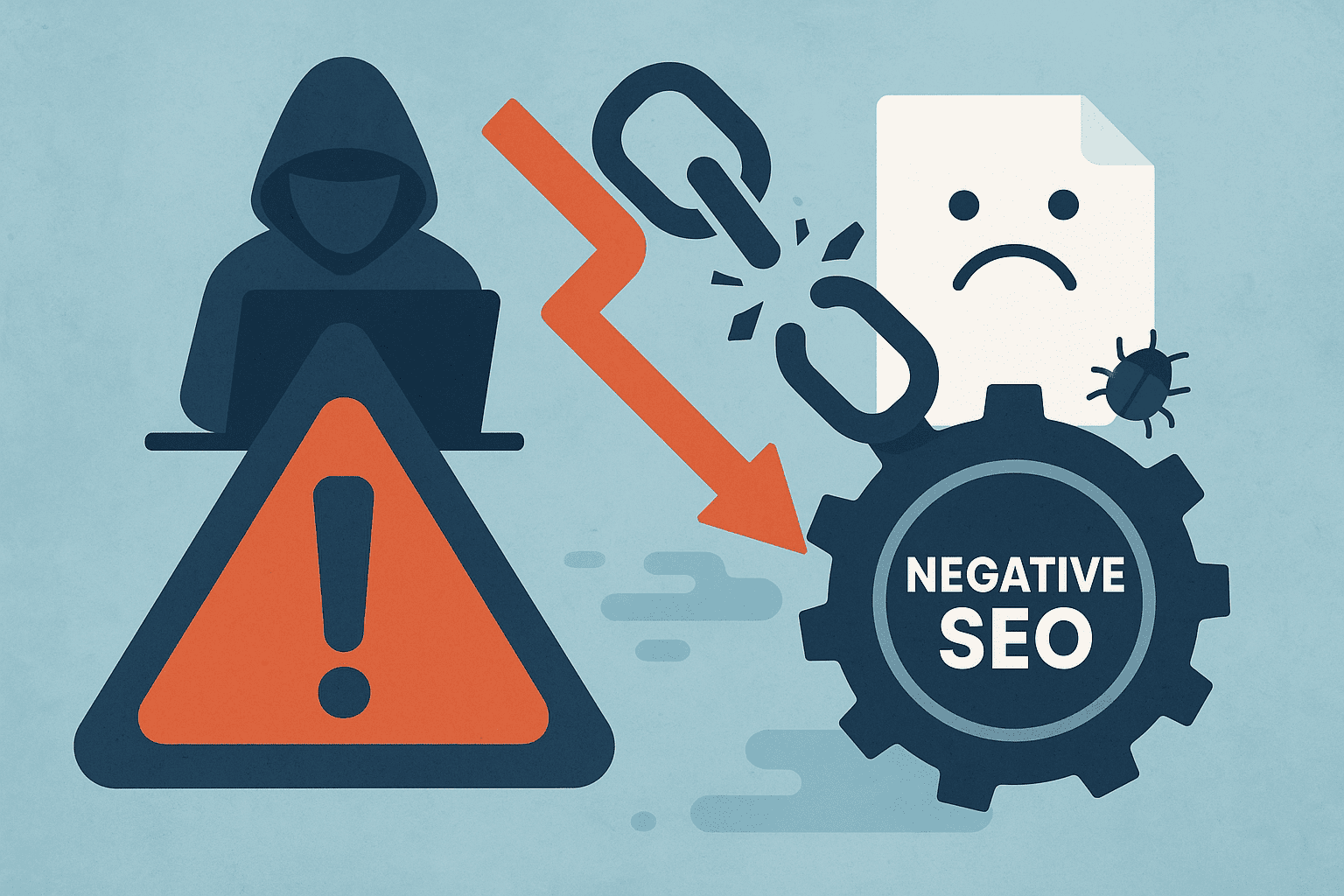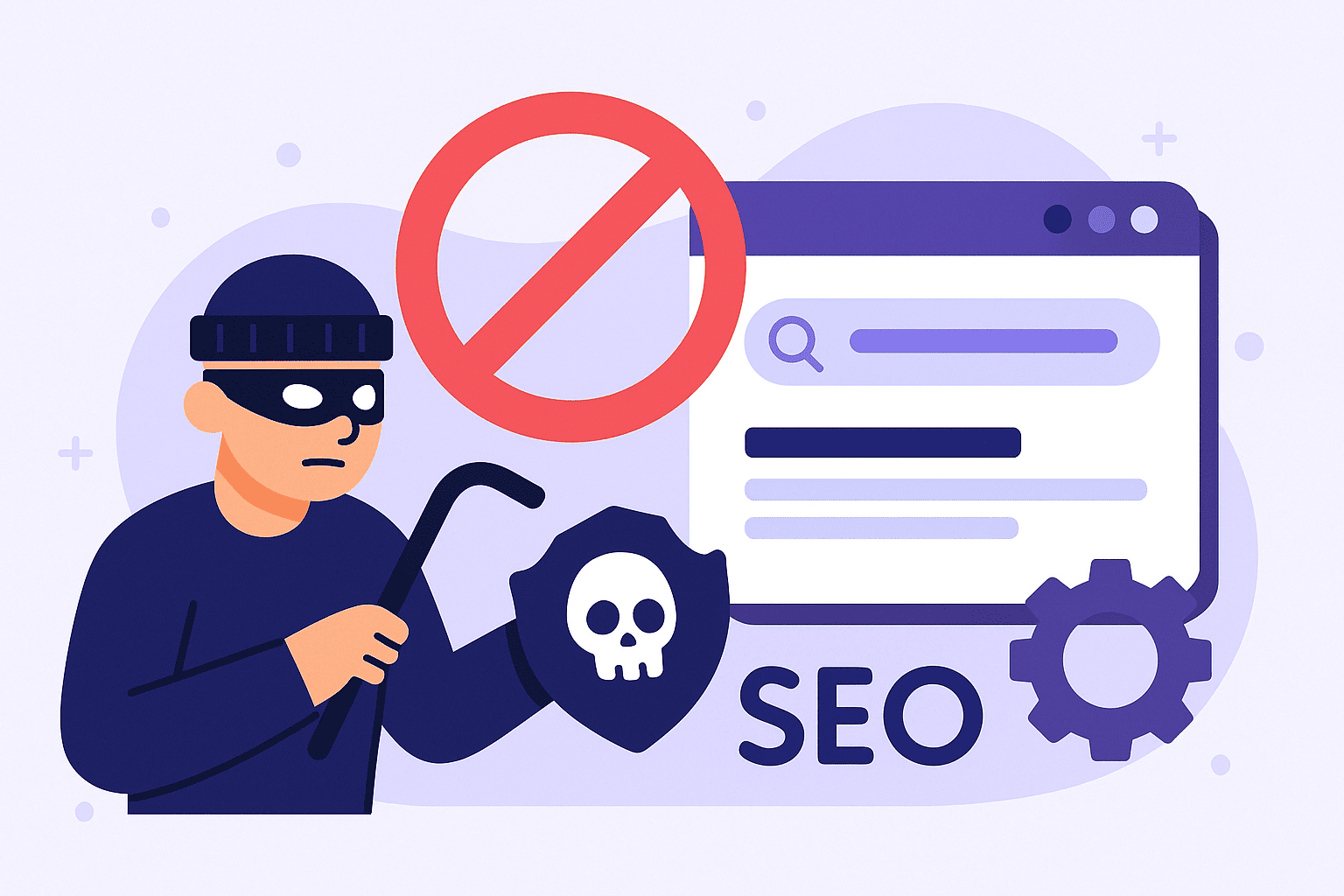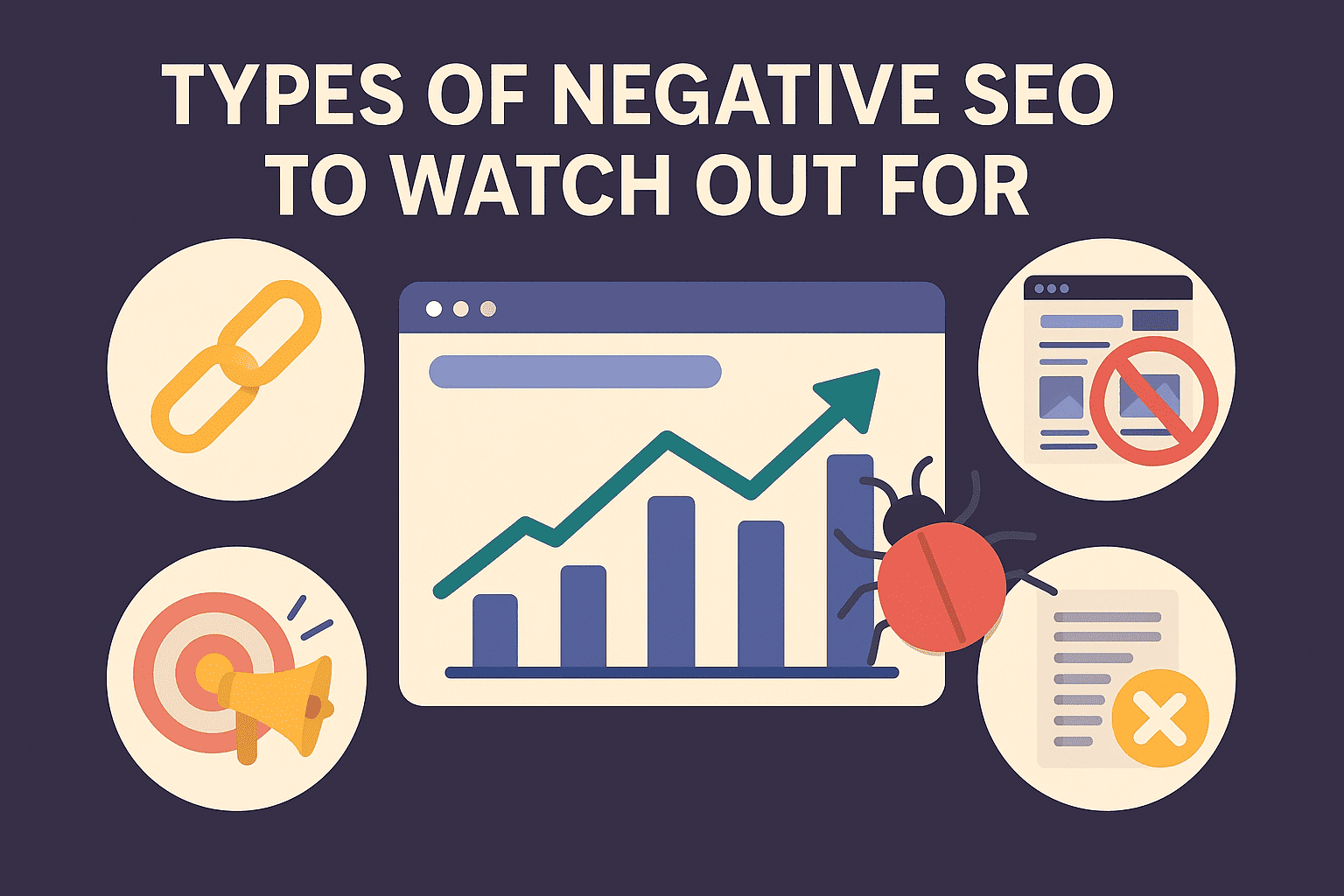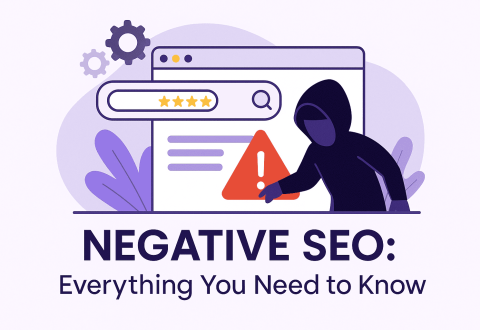Negative SEO refers to deliberate tactics used to harm a website’s rankings in search engines. These attacks often include toxic backlink blasts, content scraping, fake reviews, and security breaches — actions that can lead to penalties, traffic loss, and damage to brand credibility.
Even well-optimized websites are not immune. Search engines may interpret malicious signals as violations of their guidelines, especially if anomalies go unnoticed. That’s why early detection and prevention are essential.
This guide explains how negative SEO works in 2025, what signs to look for, which tactics are most dangerous, and how to defend your site effectively. If you rely on search traffic, protecting your rankings is no longer optional — it’s a core part of sustainable SEO.
What is Negative SEO?
Negative SEO is the practice of using unethical or manipulative tactics to harm a competitor’s visibility in search engine results. Unlike traditional SEO, which aims to improve a website’s performance, negative SEO focuses on triggering penalties, diluting authority, or damaging trust signals in Google’s ranking system.
These attacks are usually executed off-site and often go unnoticed until a drop in rankings or traffic occurs. The intent is to make it appear as if the target site is engaging in spammy or deceptive SEO practices—resulting in algorithmic devaluation or even manual penalties.
Common Tactics Used in Negative SEO:
| Tactic | Purpose | How It Hurts |
| Spammy backlinks | Flood target site with toxic links from low-quality domains | Triggers link-based penalties, damages trust signals |
| Anchor text poisoning | Use over-optimized or harmful anchor keywords | Causes over-optimization filters or misclassification |
| Content scraping | Copy and repost target content on other domains | Creates duplicate content issues, may outrank the original |
| Fake reviews and ratings | Post negative reviews on local or third-party platforms | Harms brand perception and click-through rates in SERPs |
| Hacking or malware injection | Alter site structure, redirect users, or infect pages | Results in browser warnings, deindexing, or traffic loss |
| Click-through rate (CTR) bots | Send fake clicks or bounces using automated scripts | Manipulates user signals, may lower relevance in Google’s eyes |
| Fake link removal requests | Contact referring domains to remove good backlinks | Reduces link equity and authority |
Negative SEO isn’t always sophisticated—but it doesn’t have to be. Even simple, automated attacks can destabilize rankings if left unchecked. Understanding these tactics is the first step in building an effective defense.
What are the Origins of Negative SEO?
The rise of negative SEO can be traced back to Google’s Penguin update in 2025. Prior to Penguin, search engines mostly ignored low-quality links. But after the update, sites with unnatural link profiles became vulnerable to ranking penalties.

This change gave rise to a new threat: competitors intentionally building spammy backlinks to harm your site. While Google acknowledges the existence of negative SEO, it emphasizes that these attacks are rare and usually ineffective. Still, SEO professionals understand that in competitive niches, even temporary ranking losses can lead to major business consequences.
The update marked a turning point in how the SEO community viewed link building—no longer as a solely beneficial tactic, but also a potential weapon.
How to Spot Negative SEO
Timely detection of negative SEO is crucial. While some attacks are obvious, others mimic natural SEO fluctuations and require careful analysis. Below are key indicators that your site may be under attack.
- Unusual spike in backlinks
A sudden and unnatural increase in backlinks, especially from irrelevant, foreign, or low-quality domains, is a common sign. Use tools like Ahrefs, Semrush, or Rush Analytics to check for toxic links and unusual anchor text profiles. - Appearance of duplicate content across the web
If your original content is copied and indexed on other domains, this can hurt your authority and rankings. Use Copyscape or Siteliner to detect scraped content. Pay attention to cases where duplicate pages outrank your originals. - Drop in keyword rankings without on-site changes
If rankings fall significantly without technical errors, content edits, or algorithm updates, this may indicate a negative SEO attack. A rank tracker can help pinpoint when the drop started and which keywords were affected. - Fake reviews or brand mentions
Negative SEO can include posting false reviews or misleading comments about your brand. Monitor third-party review platforms and set up Google Alerts to track brand-related activity. - Crawling or server anomalies
Heavy bot traffic or spikes in crawl rate may indicate scraping, forced indexing, or an attempt to overload the server. Review server logs and analytics for irregularities in crawl sources or request frequency. - Deindexing of key pages
If important pages are removed from Google’s index without your intervention, check for signs of injected noindex tags, canonical manipulation, or robots.txt changes. Use Google Search Console to monitor indexing status and page coverage. - Sudden changes in backlink anchor texts
Anchor text manipulation is used to trigger over-optimization filters. If you see a surge of exact-match or off-topic anchors, especially in large volumes, it’s a potential sign of sabotage.
Regular monitoring using SEO audit tools, backlink analyzers, and performance trackers helps reveal these signs early. Being proactive with audits allows you to isolate threats, respond faster, and protect your long-term rankings.
Is Negative SEO Illegal?
Most negative SEO tactics violate search engine guidelines, but only some of them are actually illegal under national or international law. Understanding this distinction is important for determining whether you can take legal action or must rely solely on technical countermeasures.
Negative SEO methods fall into two broad categories: unethical and criminal.

Unethical but not illegal
Many common attacks—such as link spamming, content scraping, or posting fake reviews—are unethical but not necessarily illegal. These practices breach the terms of service of platforms like Google, Yelp, or Trustpilot but typically don’t violate any laws. That means you can’t prosecute the attacker in court, but you can report the abuse and request removal or devaluation through official channels like Google’s Disavow Tool or DMCA notices.
Illegal and prosecutable
Some tactics clearly fall under cybercrime laws. These include:
- Website hacking or unauthorized access.
- Malware injection.
- Redirect hijacking.
- Impersonation during link removal attempts.
- Fraudulent takedown requests under false identity.
Such actions can lead to criminal charges, especially if they cause financial loss, data compromise, or reputational damage. In these cases, website owners may pursue legal remedies under local laws, such as the Computer Fraud and Abuse Act (in the US) or the General Data Protection Regulation (in the EU), depending on the nature and impact of the attack.
What website owners should do
If you suspect illegal activity:
- Document all evidence: server logs, timestamps, malicious code, communications.
- Report technical abuse to your hosting provider and domain registrar.
- File a complaint with Google or other affected platforms.
- If the damage is significant, consult with legal counsel to explore civil or criminal action.
While most negative SEO is handled through prevention, disavowals, and platform policies, severe attacks may warrant legal escalation. Knowing the boundary between unethical and unlawful behavior helps you respond appropriately and with the right level of urgency.
Is Negative SEO Relevant Today?
Despite advancements in search engine algorithms, negative SEO remains a real and relevant threat in 2025. Google’s systems are better at detecting manipulative tactics, but attackers continue to evolve. In many cases, they exploit automation, technical vulnerabilities, and the complexity of ranking signals to avoid detection.
Negative SEO is especially dangerous in industries where rankings directly impact revenue. Even short-term visibility loss can lead to measurable financial damage. The risk is higher for websites with limited security, unmanaged backlink profiles, or no monitoring processes in place.
Here are several reasons why negative SEO still matters today:
- It remains inexpensive to execute. Mass link spam, content scraping, and bot-based attacks can be automated at scale with minimal cost.
- Competitors in high-value niches use it to manipulate search results or suppress rivals during product launches or seasonal demand.
- Google’s algorithms aren’t perfect. Sites may still suffer temporary penalties from fake backlinks or behavioral signal manipulation before the system corrects itself.
- New tactics like CTR spoofing, automated link removal requests, or AI-generated fake content have expanded the attack surface.
- Reputation damage from fake reviews or false content spreads quickly and can persist in SERPs even after the attack ends.
- Internal sabotage by former employees or agencies with backend access adds another layer of vulnerability.
While Google has reduced the long-term effectiveness of some negative SEO methods, the risk of short-term disruption, reputational loss, or manual cleanup remains. That makes regular monitoring and defensive SEO strategy essential for any business that relies on search visibility.
Types of Negative SEO To Watch Out For
A wide range of tactics fall under the umbrella of negative SEO. These are the most common ones you should recognize and protect against.

1. Link Spamming / Link Farms
This involves creating a large number of low-quality backlinks pointing to your site from irrelevant or spammy domains, including PBNs and expired domains. The goal is to trigger search engine penalties or manual actions.
Spikes in link velocity and toxic anchor text patterns are red flags. Use backlink tools like SEO SpyGlass or Google’s disavow tool to reject these harmful links and prevent ranking loss.
2. Content Scraping
Scrapers copy and republish your content on multiple websites without permission. This creates duplicate content issues that may dilute your rankings or confuse search engines about which version is original.
Monitor your content using tools like Copyscape. If stolen content outranks your version, report it to Google and issue DMCA takedown requests or contact webmasters directly.
3. Hacking and Malware Injection
Hackers can inject malicious code, spammy content, or redirections into your site. These actions may cause search engines to penalize your domain or display warnings in browsers.
Protect your website with regular security audits, enable alerts in Google Search Console, and use tools like WebSite Auditor to scan for unauthorized changes.
4. Smear Campaigns and Fake Reviews
Attackers may publish defamatory reviews or social posts using fake accounts. These actions aim to hurt your brand’s online reputation and indirectly impact your search rankings.
Set up brand mention alerts, monitor key review platforms, and respond quickly to suspicious feedback. File removal requests when necessary and publicly clarify misleading information.
5. Fake Link Removal Requests
Bad actors may impersonate your brand and ask website owners to remove valuable backlinks. This undermines your link equity and trustworthiness.
To prevent this, build relationships with your referring domains, use a branded email address in outreach, and educate partners to verify all removal requests.
6. Hotlinking and Heavy Crawling
Attackers can use your server resources by embedding your media (hotlinking) or overloading your site with bots to crash it or reduce performance. This affects user experience and SEO.
Use CDN protection, limit bot access via robots.txt, and monitor server logs to detect abnormal activity.
How to Combat Negative SEO Attacks
Negative SEO cannot always be prevented — but it can be contained, mitigated, and reversed. A strong defensive strategy includes technical security, backlink monitoring, content control, and reputation management. Below are proven methods for minimizing the risk and impact of negative SEO.

Build a Positive Online Reputation
A consistent, trustworthy online presence helps offset the effects of fake reviews or defamatory content. Publish high-quality testimonials, case studies, expert contributions, and user-generated content. Claim and manage your profiles on platforms like Google Business, Trustpilot, and industry directories.
Encourage satisfied customers to leave authentic reviews and respond to negative ones with transparency and professionalism. The stronger your reputation baseline, the less visible and impactful malicious content becomes in SERPs.
Use Google’s Suite of Tools
Google Search Console is your first line of defense. Set up domain-level verification and enable email alerts. Monitor:
- Manual actions.
- Coverage issues.
- Page removals.
- Security warnings.
Use the Disavow Tool to neutralize spammy backlinks you can’t remove manually. Combine this with Google Alerts to track new mentions of your brand, domain, or executives across the web.
Enable two-factor authentication on all connected Google accounts to prevent hijacking or impersonation.
Beef Up Your Site Security
Most serious attacks begin with access—through plugins, weak passwords, or outdated software. Take the following measures:
- Use HTTPS and renew SSL certificates regularly.
- Keep your CMS, themes, and plugins updated.
- Limit admin access and enforce strong passwords.
- Run daily malware scans and enable file change alerts.
- Monitor your site’s robots.txt and canonical tags for unauthorized edits.
Security hardening prevents attackers from modifying content, injecting malware, or causing deindexing via backend access.
Keep an Eye on Your Backlink Profile
Spikes in backlinks, sudden anchor text changes, or a growing number of referring domains from irrelevant sites may indicate link spam. Monitor link data weekly using Ahrefs, Semrush, or Rush Analytics.
Sort backlinks by:
- Referring domain quality.
- Anchor text distribution.
- Link type (nofollow, dofollow).
- Geographic origin.
Report harmful links to Google using the Disavow Tool, and contact webmasters when feasible. A regularly audited backlink profile prevents long-term link-based penalties.
Monitor for Duplicate Content
Scraped content can outrank your original if it’s indexed first or linked more widely. Use tools like Copyscape, Plagscan, or Siteliner to identify duplicates. Focus on protecting:
- High-traffic blog posts.
- Product descriptions.
- Landing page copy.
Add canonical tags to original URLs and publish timestamped versions when possible. If scraping persists, issue DMCA takedown requests or file complaints with hosting providers.
Work with Your Hosting Company
Your hosting provider should support security incident response. Choose a host that offers:
- Real-time server monitoring.
- DDoS protection.
- Daily backups.
- Immediate account restoration.
If your site is compromised, contact the host to restore clean backups and isolate affected files. In shared hosting environments, ask about intrusion detection and firewall policies.
Reliable hosting is often the difference between fast recovery and prolonged downtime.
Monitor Your Online Reputation
Search engine reputation management (SERM) is essential for countering fake reviews, impersonation, or reputation hijacking. Use a SERM tool to track brand-related keywords and the sentiment of search results.
Review and tag all top-ranking URLs for branded queries as positive, neutral, or negative. Pay special attention to:
- Review aggregators.
- News mentions.
- Reddit and forum threads.
- YouTube and social media pages.
Respond to threats early by promoting owned content, building knowledge panels, and issuing takedown requests where necessary.
Free 7 days access to all tools. No credit card required!
Попробовать бесплатно
Conclusion
Negative SEO remains a threat in 2025. While search engines have become better at detecting manipulation, attackers have become more subtle and persistent.
The best defense is proactive: secure your website, track your backlink and content profiles, respond quickly to fake reviews, and build a resilient online presence. The earlier you detect attacks, the easier it is to neutralize them and maintain your site’s credibility, traffic, and conversions.
Stay vigilant. The health of your rankings depends on it.
FAQs
Is negative SEO illegal?
Negative SEO is unethical and violates search engine guidelines, but it’s not always illegal—except in cases involving hacking or impersonation.Does negative SEO still work?
Yes. While not always effective, these tactics can cause ranking drops, traffic loss, and reputation damage if left unaddressed.How to do negative SEO?
We do not encourage or condone unethical tactics. This article is focused on prevention and defense.What is bad SEO vs good SEO?
Bad SEO involves manipulative, deceptive, or spammy tactics. Good SEO focuses on user-first strategies that align with search engine rules and long-term value.






